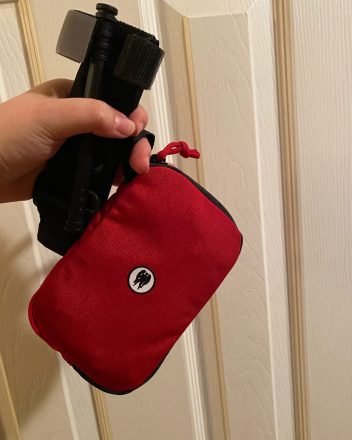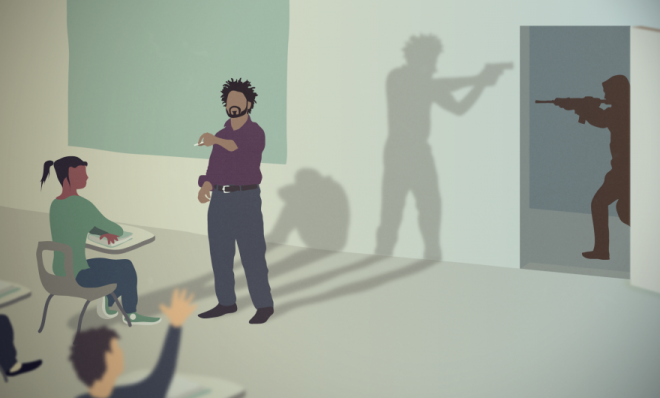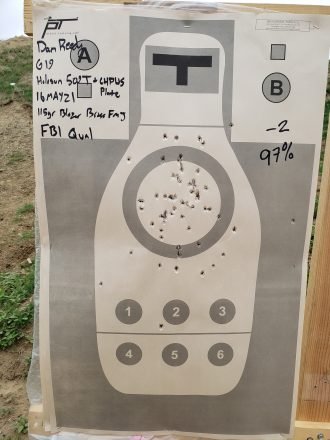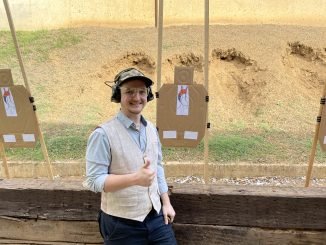
If you haven’t already, go read Part I of The Armed Teacher >>HERE<<
In part II of this series we are going to address some of the questions concerning equipment, performance standards, and protocol concerning armed teachers. Before allowing teachers to carry guns into school, we need to ensure that they have the safest equipment, and are able to meet basic firearm shooting standards. Additionally, we want our teachers to know under what circumstances they would be allowed to draw their weapon, and what to do afterwards.
Equipment Selection for Armed Teachers
Our minds quickly go to what guns would be best for use in the classroom. While we want to ensure that our teachers are armed with the most reliable and effective weapons, we must consider their holsters, and what less lethal options to offer. Teachers carrying medical should be a requirement, whether teachers in your school are armed or not, regardless of political affiliation.
Weapons
When considering what kind of equipment to arm teachers with we should look at what is approved by most police departments. The school district should make the decision to either provide a weapon to designated teachers, or require their purchase from a pre-approved list of acceptable weapons. Below are some recommendations for weapons, ammunition, and associated equipment . These recommendations are not exhaustive, but provide a solid foundation.
Handguns
Handguns are the most obvious choice for arming teachers. This allows staff to keep their firearm secure and concealed on their person until it becomes necessary. A handgun may not provide the best stopping power, but it offers the best versatility for staff. Some options commonly issued by law enforcement and militaries across the country include:
- Glock
- Smith & Wesson
- CZ
- Sig Sauer
- Beretta
- Walther
- H&K
- FN
- Colt
Caliber selection should be based upon ability to meet FBI standards on penetration, and expansion when using quality ammo. Again, this is a place where matching on and off duty options for local law enforcement could be a good jumping off point. Calibers could include:
- 9×19
- .40S&W
- .45ACP
- .357SIG
- .38 Special
In addition to caliber, specific loads will need to be selected for superior performance. A few examples with good track records include the following:
- Speer Gold Dot
- Federal HST
- Winchester Ranger-T
- SIG V-Crown
- Hornady Critical Duty
Shotguns
Shotguns can be an excellent tool when put in the right hands. Offering unparalled ability to stop threats in short order, they continue to hold their own against more modern offerings. Both pump action and semiautomatic shotguns provide pros and cons to the users, with excellent options being available in both types.
- Remington
- Winchester
- FN
- Mossberg
- Beretta
- Benelli
Caliber selection:
- 12 Gauge
Specifically the 12 gauge is chosen because it has the widest variety of gun selection and the best choices for defensive loads. These are often severely lacking when it comes to other gauges, such as the 20. Regarding loads, 00 buckshot and #1 buckshot will be the optimal choices, combining excellent wound ballistics, as well as tight patterns for accountability. Options such as Federal Flite Control 8 pellet, and Hornady Critical Defense provide both of the above qualities, along with reduced recoil and high reliability.
Rifles and Carbines
For the past few decades, law enforcement across the country has been adopting patrol carbines for officers, making overwhelming use of the AR-15. These allow the user to place more accurate, and powerful rounds at greater ranges than possible when using handguns or shotguns. Additionally, the learning curve is often less steep for new users than with other types of firearms. While there are other quality rifles available, the AR-15 is going to be the best option for arming teachers, for reasons we won’t delve into here. Those living in ban states may have to look for alternative solutions. Some quality manufacturers include:
- BCM
- Colt
- Daniel Defense
- FN
- Smith & Wesson
- SIG Sauer
- SOLGW
Caliber:
- .223
- 5.56
Caliber selection is very straightforward, simply match the round to your rifle. The 5.56 is the standard for military and law enforcement across the nation. Combining high degrees of accuracy, capacity, and reliability, paired with low recoil, along with fantastic wound ballistics, .
Holsters
When deciding on holsters, we need to choose the safest options. Any kydex holster that fully encloses the trigger guard is a safe starting choice. This will ensure that nothing can get in and pull the trigger, causing a negligent discharge.
A handgun must be concealed on their person. Open carry is not only a poor choice from a tactical stand point, but will distract from the learning environment in the classroom. The holster needs to affix to the belt via Pull-the-Dot loops, or by a spring steel clip like those from Discrete Carry Concepts. If you prefer to not wear a belt, tuck your shirts in, or wear a dress or skirt, the PHLster Enigma is the safest option.
Concerning off body carry, such as in a purse, backpack, or in your desk: this cannot be allowed inside the classroom. There is too much opportunity for someone else to get their hands on your gun. Teachers must retain control of their firearm at all times.
Requirements of a holster
Tom Givens’ requirements for concealment holsters
- Comfortable
- You’re going to wear it all day. This prevents the user from continuously adjusting the holster, and will not significantly impede mobility.
- Concealable
- Will not print. Holsters should use a claw, and a wedge to improve concealability.
- Safe
- Fully encloses the trigger guard. Secure on the belt (or Enigma), so that the holster does not join the gun when drawing.
- Sticky Holsters, Belly Bands, and “tactical leggings” would not meet the safety requirements.
- Fast
- Easily accessible by the user to ensure rapid drawing of the firearm.
- Fully encloses the trigger guard. Secure on the belt (or Enigma), so that the holster does not join the gun when drawing.
Less Lethal
If you have teachers who are not comfortable having a gun on their person or in their classroom, you could offer a less lethal option. Offering OC sprays to be carried by teachers or kept in locked drawers in their desks would be an easy option. The choice in OC spray should take into consideration the size of canister, and what is a legally allowed formula strength in your state/jurisdiction. I would recommend an aerosolized version that sprays in a stream or a cone. POM and Sabre are quality brands, and are part of my EDC.
An inconspicuous alternative option could be a fire extinguisher. These could be placed in every classroom of the school in case there is a localized fire, or to use on an intruder. The fire extinguisher can blind the threat, and could cause significant respiratory issues. Additionally, the fire extinguisher could be used as an impact weapon in a worst case scenario.
Medical

Every classroom in America needs to have a trauma kit. When emergency medical response arrives on the scene of a mass shooting they need to wait until the police have given them the clear to enter the building. Clearing a school is often a daunting task as there are so many classrooms, restrooms, and hallways. They want to be certain that the paramedics are not going to become secondary victims once they enter the school. All of the waiting will result in deaths of teachers and students. This is why teachers need to have trauma kits in their classrooms.
At a minimum your classroom trauma kit should include:
- CAT or SOFTT-W tourniquets, 3-5x units
- Hemostatic gauze (Celox, Quikclot, etc), 3-5x units
- Chest seals (Hyfin, Halo, etc), 3-5x units
FASTER offer pre-built kits for situations like these Unfortunately, it is not realistic to have enough medical for every single student for most schools/classrooms. One teacher in a classroom of 20-30 students would not have the time to assess the injuries, apply tourniquets, pack the wounds, and apply chest seals to all of their students. Don’t let this stop you from having enough for each student, if you have the financial means, go for it.
Additionally your trauma kit could include:
- Gauze
- Compression bandages
- Trauma shears
- Medical tape
- Sharpies
Ideally what is in your trauma kit is only going to be used until paramedics can enter the building.
I would recommend that you purchase medical either directly from the manufacturer, or from a reputable distributor. Many of the medical supplies you can find on Amazon are low quality and/or counterfeit.
Room Security

Ideally you should not have to shoot the active shooter. If you can secure your classroom door so that they cannot get in, that should be the ideal. I worked in one district where they taught us to barricade our doors by putting the heaviest objects against it. This only worked if you had an inward opening door. If we had outward opening doors we could still try barricading as it would make it more difficult for the shooter to enter our room. Unfortunately, that only bought us moments, not our life. Another school I worked in utilized the Barracuda Intruder Defense System. We put this under our door and locked it in place. This device worked for inward and outward opening doors.
Talk to your school board to discuss what options may be available to help secure doors in an active shooter.
Conclusion on Weapons, Less Lethal, and Medical
Discuss with your school board and local law enforcement to determine what equipment is going to best meet the needs of your school and district. Choose equipment that is objectively safest and most reliable. Assemble trauma kits for each classroom and train your teachers on how to use it. Stop the Bleed will often come to your school for free and will teach you how to use the equipment you put in your classroom trauma kits. You could even add Stop the Bleed to the Health Class curriculum so that older students can learn this life saving skill.
Procedures and Protocol
If there is legal means for a teacher to have a gun on school property, and if it is decided to be a feasible option in your district, we need to consider the procedures and protocols. The school district or board needs to work closely with law enforcement to establish safety measures within the school. We also need to answer the question, what is the teacher’s job? To protect the school by hunting down an active shooter, or to teach and protect their students?
Note: Before arming teachers the district must have clear cut, unambiguous policy in place for when it is acceptable to expose their firearm. There should be zero doubt for if and when it is appropriate to draw their weapon. Policy must include consequences of violating policy. Additionally, policy must specifically outline what support will be available for teachers in the event they use their defensive tools against attackers.
Procedures
To clarify, these are procedures that will only be in place in the event that there is an active shooter in the building. This should not be used for small scale, interpersonal violence like fights between students. These procedures should cover everything from notifying law enforcement of an active shooter, and what to do if they make it into your classroom. From my experience working in schools, you should not have to completely rewrite your emergency response plan once you decide to arm teachers. The decision to arm teachers should only add additional steps to the designated teachers.
Example Procedures of Armed Teacher Response to an Active Shooter
-
Call 911
- Remind them that there are armed teachers in the school. All the local emergency response teams should already be aware, however it would be good to remind them.
-
Alert school over intercom
- Code red, intruder, whatever you would normally say in this situation.
-
Go into lockdown.
- Everyone needs to go into lockdown as normal. Lights off, doors locked, students and staff out of view. Keep students as far from the entry points as possible in case you have to shoot.
- NO ONE is to leave the classroom, not even the armed teacher.
At this point, if you have a long gun, you should get that out from its secure location. If you are conceal carrying, keep the gun concealed until the threat has entered your locked classroom. It would be helpful for armed teachers, school administrators and law enforcement to go to each classroom to help establish safe directions for teachers to shoot from if the threat managed to penetrate their classrooms.
If the threat enters your classroom you are permitted to shoot them. Be conscious of where your students are located. Do not use them as a backstop, and try to keep your body away from them. The intruder will likely refocus their attention on you if you are shooting at them. If the intruder retreats into the hall, secure your door again. You should not chase the intruder out of your classroom, or shoot down hallways.
If you have fired your gun you need to alert the school office and law enforcement. Call the office over your phone or intercom and let them know who is calling, what room you’re in, that you shot (at) the intruder, and that they are either in your room, or ran off. That way law enforcement can anticipate finding an armed teacher in your room, and know whether or not the threat was stopped.
After the school is cleared by law enforcement, dismiss students classroom by classroom and relocate them according to your emergency plan.
Stay in the Classroom, or Go Hunting?
At the end of the day, the job of the educator is to teach students, and to protect them. Teachers are not law enforcement, they are not school security. If arming teachers detracts or distracts from teaching then they are not doing their job.

Teachers, armed or not, should not leave the classroom in the event of an active shooter. Teachers hunting in the halls could potentially leave classrooms of 20+ students alone while there is an active shooter in their school. In this event teachers need to remain in their classrooms. There are times throughout the school day that a teacher may not have their students in their room. Even with an empty classroom, teachers must stay within their room. Teachers hunting in the halls would get in the way of law enforcement, or worse, could be mistaken for the active shooter.
Protocols
Appropriate equipment has already been determined, teachers have already been vetted, now what? Now we have to consider the day to day interactions with the guns. Some examples of this might include:
- Handguns are concealed on the person in a permitted holster
- Rifle is to remain in a locked cabinet/safe until it is an appropriate time to take out
- Do a morning check on rifle and ammunition before students arrive and report to administration
- Do an afternoon check on rifle and ammunition after students are dismissed and report to administration
- Stay up to date on training schedule and certification schedule
- Maintain a regular maintenance schedule
- Students and other faculty do not need to know who is an armed teacher
Doing regular checks on your rifle is going to ensure that it does not go missing overnight or during the day. If you find that a rifle is missing the school goes on lockdown until it can be located. Local law enforcement should also be alerted.
Create a training schedule with local law enforcement, but also reach out to other organizations or other instructors to come in and work with all of your teachers. You don’t have to limit training to the armed teachers, everyone in your school can benefit from training such as OC and less lethal options, Stop the Bleed, and other first aid.
A Need-to-Know Basis
Parents, students, and other teachers do not need to know who the armed teachers are, or if there are armed teachers in the building. This knowledge could have a negative impact on the learning environment if it were to be released to students. According to a March 2018 National Education Association (NEA),
“Members oppose arming fellow teachers by a wide margin. Nearly three-quarters of respondents were opposed to arming teachers and other school employees and 64 percent stated that they’d feel less safe knowing that they worked with armed fellow work employees”.
The NEA has around 3 million members, and a significant portion of them are not fond of the idea of arming teachers. Knowing this, it is best to keep the names of armed teachers and their locations on a need-to-know basis.
Conclusion on Procedures and Protocols
Work closely with local law enforcement to create procedures and protocols that will keep teachers and their students safe. You should not have to completely rewrite active shooter/intruder procedures once you decide to arm teachers.
Standard of Performance and Training Requirements
Arming teachers provides them with a potentially life-saving tool, however they are no longer the average armed citizen. A part of their job becomes using lethal force to protect their students if necessary. An armed teacher needs to have a standard of performance and must meet training requirements.
Standard of Performance
The standard of performance will be the minimum of what a teacher must be able to perform in order to have a firearm on their person, or in their room. This minimum must meet what is expected of local law enforcement. Additionally, if a teacher is conceal carrying in the classroom they must have completed what is required and expected in their state and/or jurisdiction for a conceal carry permit.
Having a standard of performance is necessary when considering the nature of a school.
Inside a school there is no safe direction. There are people on the other side of nearly every wall. At times the separating walls are thin fabric dividers between classrooms. In multiple story school buildings, there is a relatively thin separation between those above and/or below you. Knowing your bullet could enter any other classroom and potentially hit another student makes the stakes much higher if you miss your intended target.

Shooting in a crisis with children present is a learned skill. If you have been in a classroom with children during an active shooter drill you know that they are wiggly and chatty. Some of your students will not sit still. Knowing this, you may have to control a class of 18-30 children while preparing to shoot someone who enters your classroom. Having a standard ensures that all of the teachers have received and passed the necessary training to perform the task at hand.
Using your gun is going to be a highly stressful situation and you will not perform as well as you do when you practice at the range. It would be encouraged that you practice by inducing some stress on yourself through competition, force on force training, and more.
Training Requirements
Again, training requirements should be similar to that of local law enforcement, however the school district could ultimately decide what is best for their teachers. There must be required firearm training that is district sponsored, but optional training should also be allowed at the teacher’s expense.
Required Training
Required training is training provided by the district and is mandatory for participating teachers. This would be a similar concept to required professional development hours for academics each year. I would encourage districts to hold firearm professional development (PD) training days to be separate from the academic focused PD days.
Optional Training
Optional training is training that teachers voluntarily request to attend. The district can determine if they would like to pay for tuition to the class, or provide a stipend for the armed teacher. Neither should be required nor expected, but should be handled similarly to teachers request to attend professional development and academic conferences. Teachers should be able to request professional development leave to attend the class. Usually this is subject to administrative approval and is separate from vacation, sick leave, or paid time off (PTO). If a request is denied for PD, teachers could still take off using their PTO to attend further training.
Conclusion for Standard of Performance and Training Requirements
Armed teachers are no longer average conceal carriers. The nature of a school is different than the grocery store, or the mall and the stakes are higher. Having a standard of performance ensures that all of your armed teachers can perform at a minimum ability. Having consistent training ensures that the armed teachers in your school and/or district know what to do in an active shooter situation, and are capable of stopping the threat. Your students and teachers are going to be in better hands than those of the average conceal carrier.





Be the first to comment